Rock-Fill Cofferdam Crest Settlement Behavior Analysis Through Geodetic Monitoring Data
Abstract
:1. Introduction
2. Materials and Methods
2.1. Monitoring Location and Strategy
2.2. Monitoring Data
2.3. FNSE Model and Monitoring Adjustment
3. Results and Discussion
3.1. Monitoring Results and Analysis
3.2. Monitoring Adjustment and Settlement Prediction
4. Conclusions
- (i)
- During filling of reservoir the settlement of observed points on cofferdam crest is behaving in a nonlinear fashion, slowly ceasing and asymptotically approaching its final value.
- (ii)
- FNSE model can be used to predict the settlement of the crest.
- (iii)
- With the use of a decision algorithm and the FNSE model, monitoring adjustment can be implemented to optimize the time and intensity of future measurements.
Author Contributions
Funding
Acknowledgments
Conflicts of Interest
References
- Dounias, G.T.; Anastasopoulos, K.; Kountouris, A. Long-term behaviour of embankment dams: Seven Greek dams. Proc. Inst. Civ. Eng. Geotech. Eng. 2012, 165, 157–177. [Google Scholar] [CrossRef]
- Yavaşoğlu, H.H.; Kalkan, Y.; Tiryakioğlu, İ.; Yigit, C.O.; Özbey, V.; Alkan, M.N.; Alkan, R.M. Monitoring the deformation and strain analysis on the Ataturk Dam, Turkey. Geomat. Nat. Hazards Risk 2018, 9, 94–107. [Google Scholar] [CrossRef] [Green Version]
- Desmond, N.D.H.; Gregory, B.B. Risk and Uncertainty in Dam Safety; Thomas Telford Publishing, Thomas Telford Ltd.: London, UK, 2004. [Google Scholar]
- Zhong, D.; Cui, B.; Liu, D.; Tong, D. Theoretical research on construction quality real-time monitoring and system integration of core rockfill dam. Sci. China Ser. E Technol. Sci. 2009, 52, 3406–3412. [Google Scholar] [CrossRef]
- Scaioni, M.; Marsella, M.; Crosetto, M.; Tornatore, V.; Wang, J. Geodetic and remote-sensing sensors for dam deformation monitoring. Sensors 2018, 18, 3682. [Google Scholar] [CrossRef] [PubMed] [Green Version]
- Hunter, G.; Fell, R. The Deformation Behaviour of Rockfill; UNICIV Report No. 405; University of New South Wales: Sydney, Australia, 2002. [Google Scholar]
- Gikas, V.; Sakellariou, M. Settlement analysis of the Mornos earth dam (Greece): Evidence from numerical modeling and geodetic monitoring. Eng. Struct. 2008, 30, 3074–3081. [Google Scholar] [CrossRef]
- Acosta, L.E.; De Lacy, M.; Ramos, M.I.; Cano, J.P.; Herrera, A.M.; Avilés, M.; Gil, A.J. Displacements study of an earth fill dam based on high precision geodetic monitoring and numerical modeling. Sensors 2018, 18, 1369. [Google Scholar] [CrossRef] [Green Version]
- Clements, R.P. Post-construction deformation of rockfill dams. J. Geotech. Eng. 1984, 110, 821–840. [Google Scholar] [CrossRef]
- Guler, G.; Kilic, H.; Hosbas, G.; Ozaydin, K. Evaluation of the movements of the dam embankments by means of geodetic and geotechnical methods. J. Surv. Eng. 2006, 132, 31–39. [Google Scholar] [CrossRef]
- de Lacy, M.C.; Ramos, M.I.; Gil, A.J.; Franco, Ó.D.; Herrera, A.M.; Avilés, M.; Domínguez, A.; Chica, J.C. Monitoring of vertical deformations by means high-precision geodetic levelling. Test case: The Arenoso dam (South of Spain). J. Appl. Geod. 2017, 11, 31–41. [Google Scholar] [CrossRef]
- Saidi, S.; Houimli, H.; Zid, J. Geodetic and GIS tools for dam safety: Case of Sidi Salem dam (northern Tunisia). Arab. J. Geosci. 2017, 10. [Google Scholar] [CrossRef]
- Guedes, Q.M.; Silva, I.D. Technical report: Shell dam horizontal displacement monitoring-comparative study using geodetic measurement, optical plumb and GPS technologies. J. Appl. Geod. 2009, 3, 249–255. [Google Scholar] [CrossRef]
- Ehrhart, M.; Lienhart, W. Object tracking with robotic total stations: Current technologies and improvements based on image data. J. Appl. Geod. 2017, 11, 131–142. [Google Scholar] [CrossRef]
- Ghilani, C.D. Elementary Surveying: An Introduction to Geomatics; Pearson Education Limited: Boston, MA, USA, 2016; Volume 14. [Google Scholar]
- Alcay, S.; Yigit, C.O.; Inal, C.; Ceylan, A. Analysis of Displacement Response of the Ermenek Dam Monitored by an Integrated Geodetic and Pendulum System. Int. J. Civ. Eng. 2018, 16, 1279–1291. [Google Scholar] [CrossRef]
- Barzaghi, R.; Cazzaniga, N.E.; De Gaetani, C.I.; Pinto, L.; Tornatore, V. Estimating and comparing dam deformation using classical and GNSS techniques. Sensors 2018, 18, 756. [Google Scholar] [CrossRef] [Green Version]
- Montillet, J.P.; Szeliga, W.M.; Melbourne, T.I.; Flake, R.M.; Schrock, G. Critical infrastructure monitoring with global navigation satellite systems. J. Surv. Eng. 2016, 142. [Google Scholar] [CrossRef] [Green Version]
- Chrzanowski, A.; Szostak-Chrzanowski, A. Deformation monitoring surveys—Old problems and new solutions. Rep. Geod. 2009, 2/87, 85–103. [Google Scholar]
- Mukupa, W.; Roberts, G.W.; Hancock, C.M.; Al-Manasir, K. A review of the use of terrestrial laser scanning application for change detection and deformation monitoring of structures. Surv. Rev. 2017, 49, 99–116. [Google Scholar] [CrossRef]
- Anghel, A.; Vasile, G.; Boudon, R.; D’urso, G.; Girard, A.; Boldo, D.; Bost, V. Combining spaceborne SAR images with 3D point clouds for infrastructure monitoring applications. ISPRS J. Photogramm. Remote Sens. 2016, 111, 45–61. [Google Scholar] [CrossRef]
- Szostak-Chrzanowski, A.; Deng, N.W.; Li, M.; Massiéra, M. Discussion on monitoring and deformation aspects of concrete face rockfill dam. Yantu Gongcheng Xuebao Chin. J. Geotech. Eng. 2008, 30, 1651–1656. [Google Scholar]
- Singh, V.P. Dam Breach Modeling Technology; Water Science and Technology Library: Dordrecht, The Netherlands, 1996; Volume 17, p. 242. [Google Scholar]
- Yigit, C.O.; Alcay, S.; Ceylan, A. Displacement response of a concrete arch dam to seasonal temperature fluctuations and reservoir level rise during the first filling period: Evidence from geodetic data. Geomat. Nat. Hazards Risk 2016, 7, 1489–1505. [Google Scholar] [CrossRef] [Green Version]
- Pytharouli, S.I.; Pytharouli, S.I.; Stiros, S.C. Investigation of the parameters controlling the crest settlement of a major earthfill dam based on the threshold correlation analysis. J. Appl. Geod. 2009, 3, 55–62. [Google Scholar] [CrossRef]
- Battaglio, M.; Bellomo, N.; Bonzani, I.; Lancellotta, R. Non-linear consolidation models of clay which change type. Int. J. Non-Linear Mech. 2003, 38, 493–500. [Google Scholar] [CrossRef]
- Gottschalk, P.G.; Dunn, J.R. The five-parameter logistic: A characterization and comparison with the four-parameter logistic. Anal. Biochem. 2005, 343, 54–65. [Google Scholar] [CrossRef] [PubMed]
- Vulić, M. Sigmoidna Funckija (Internal Mine Surveying Lecture Series); University of Ljubljana, Faculty of Natural Sciences and Engineering: Ljubljana, Slovenia, 2013. [Google Scholar]
- Hayter, J.A. Probability and Statistics for Engineers and Scientists, 4th ed.; Brooks/Cole: Boston, MA, USA, 2013. [Google Scholar]
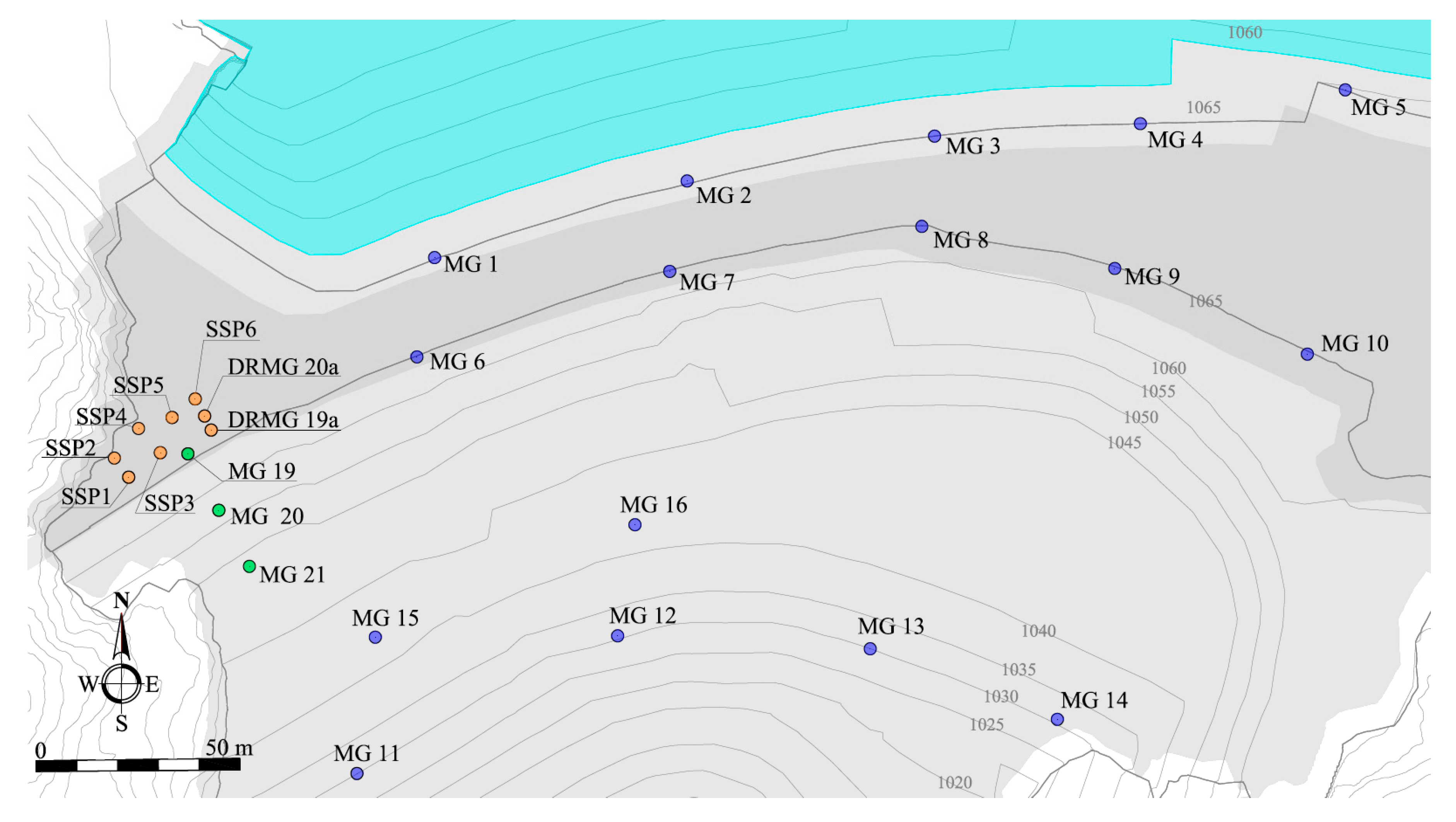
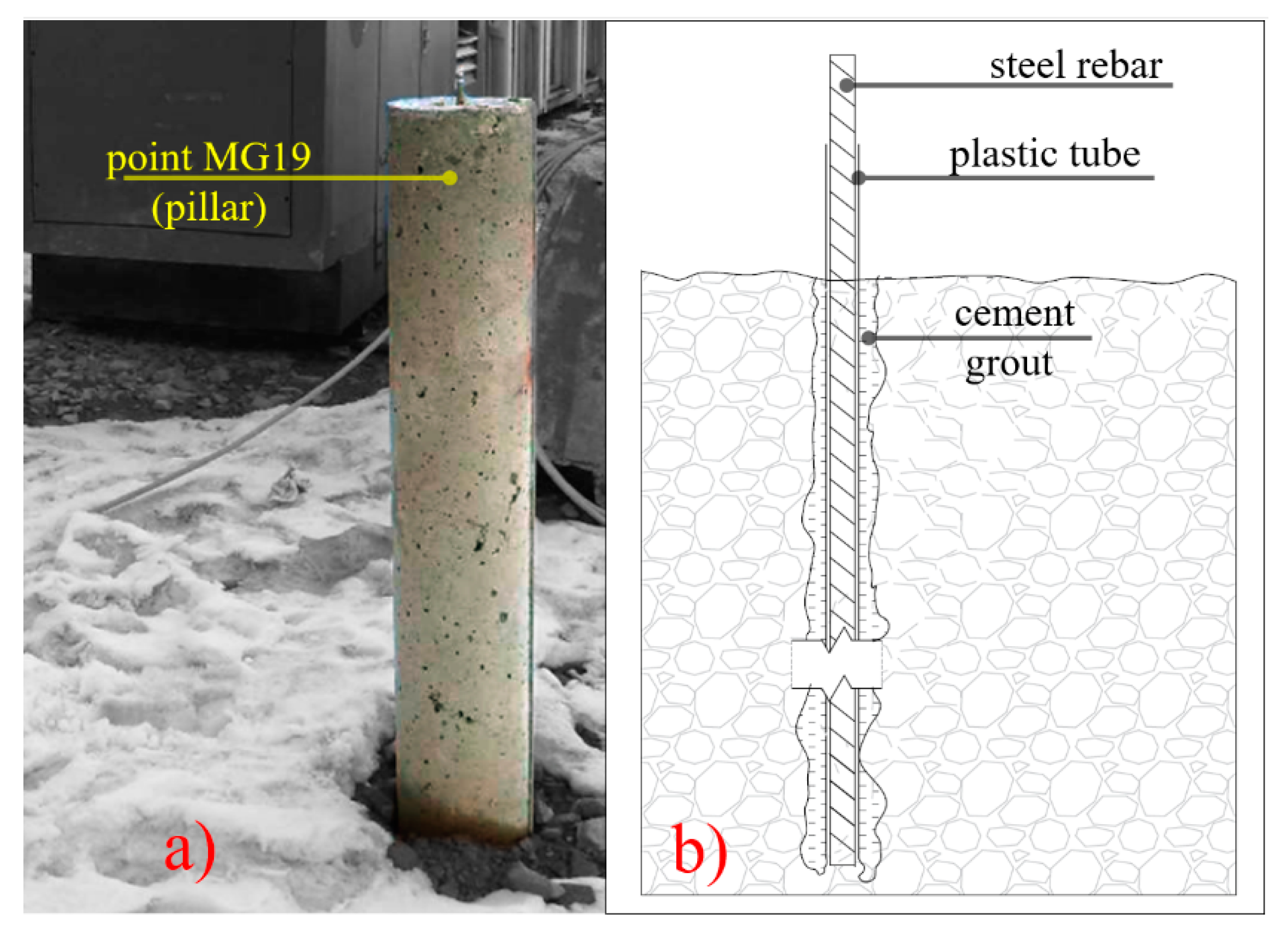



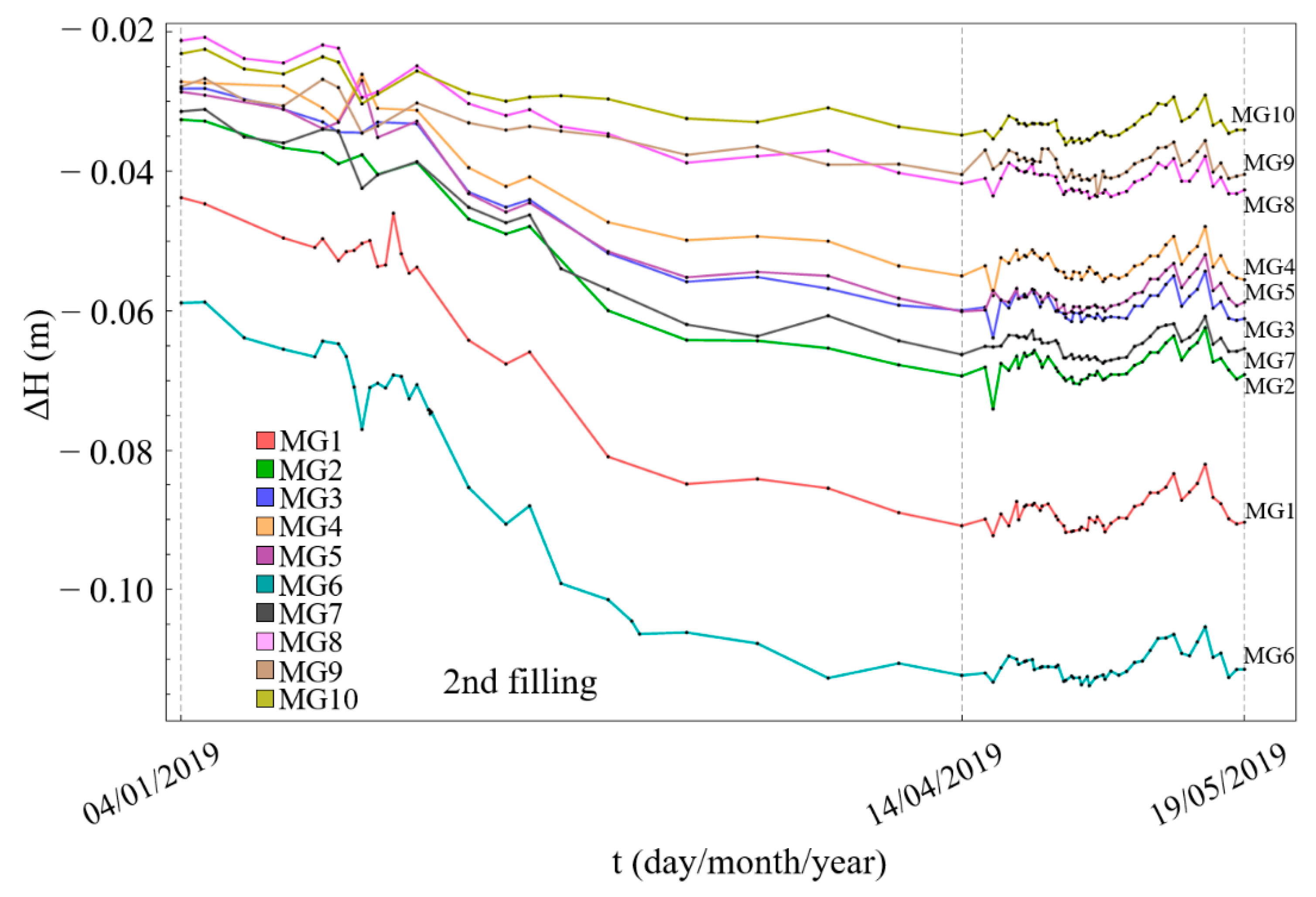
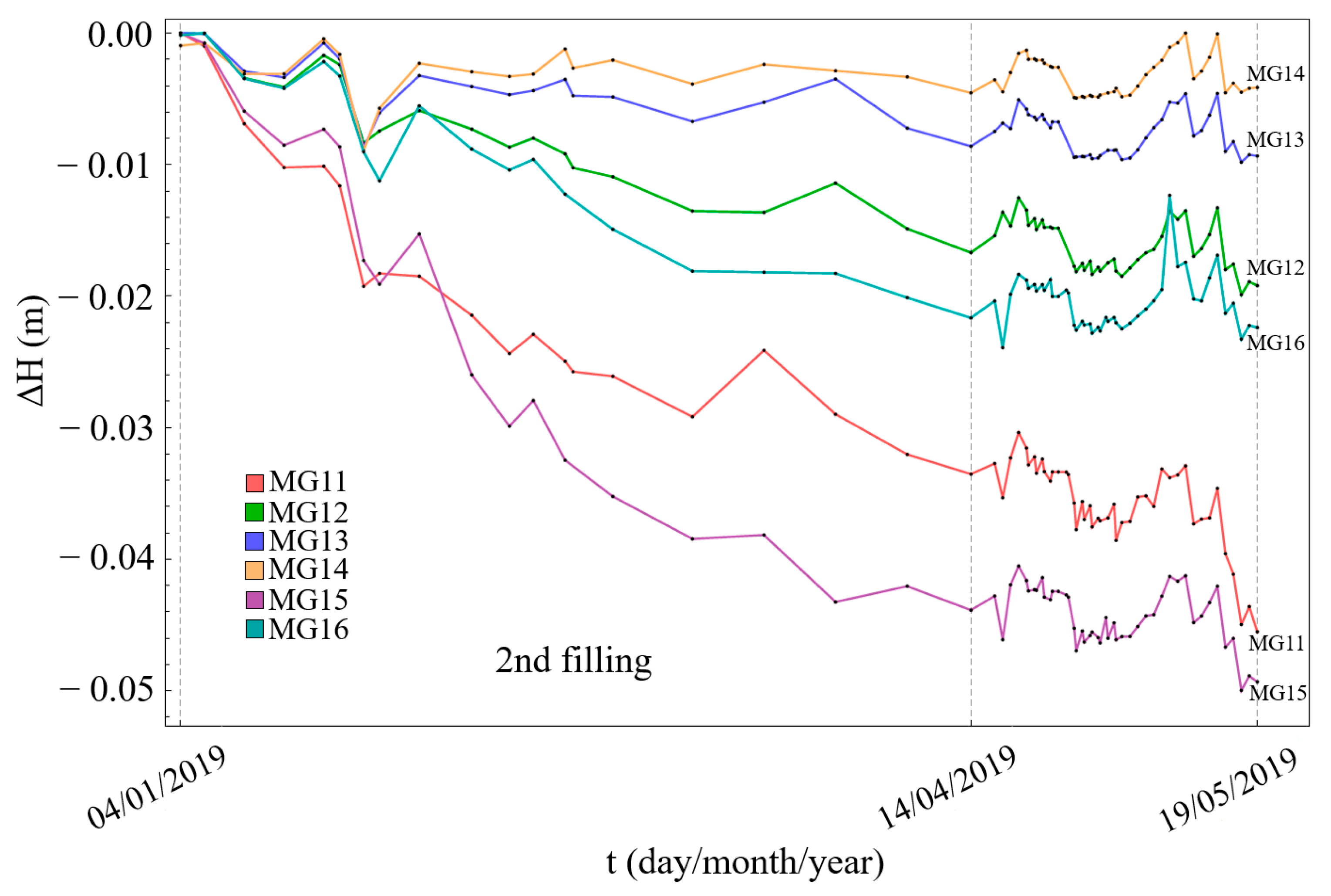
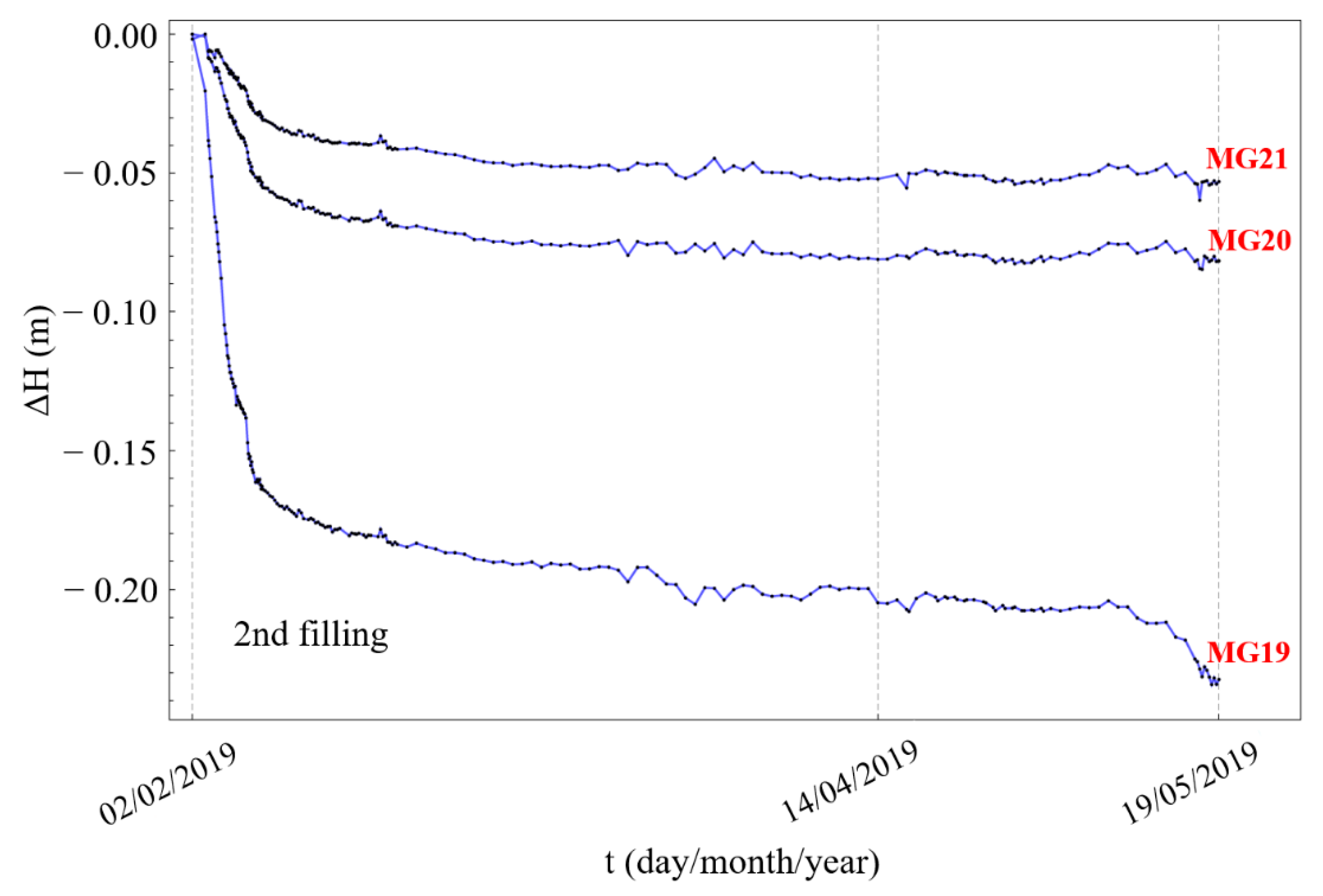



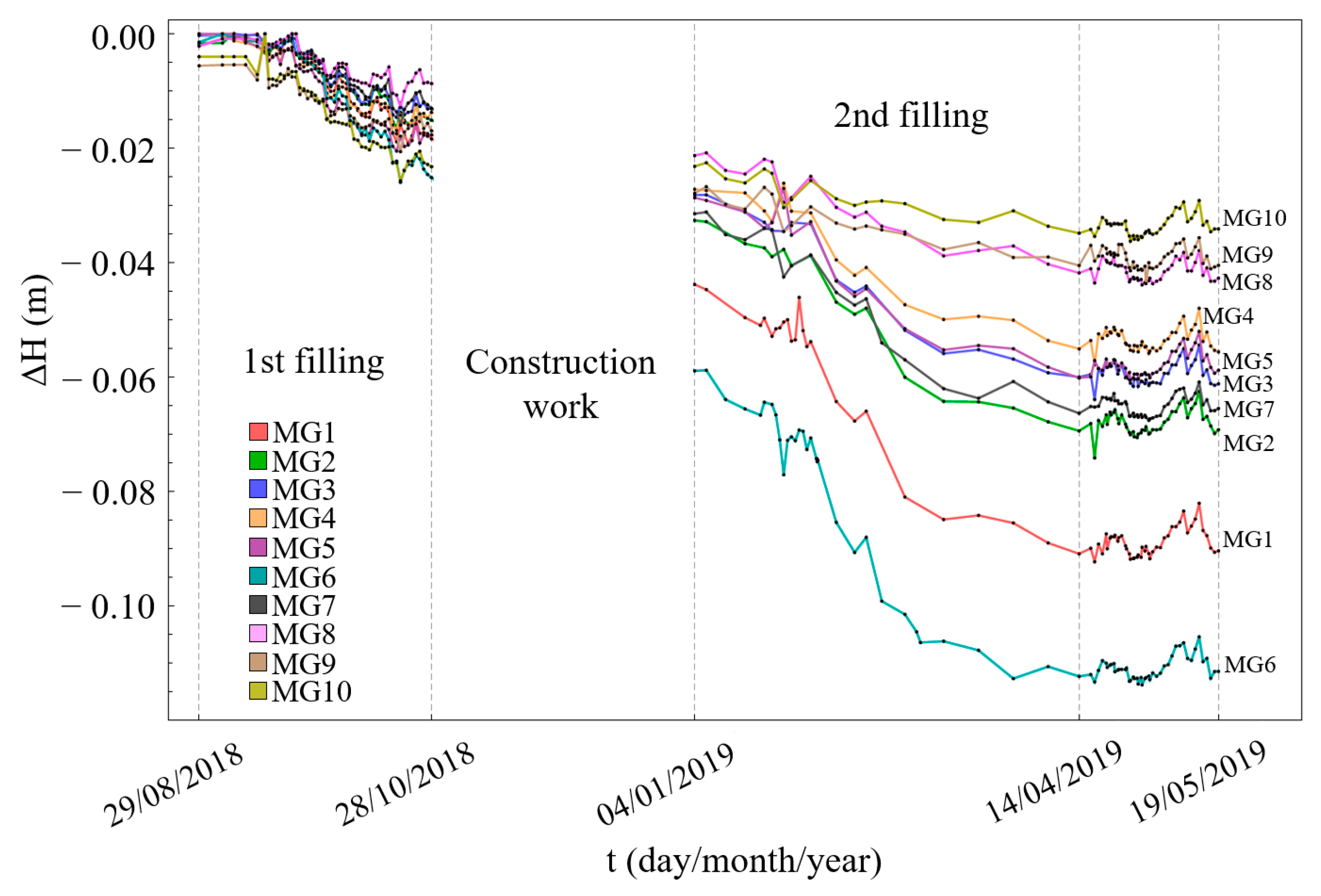
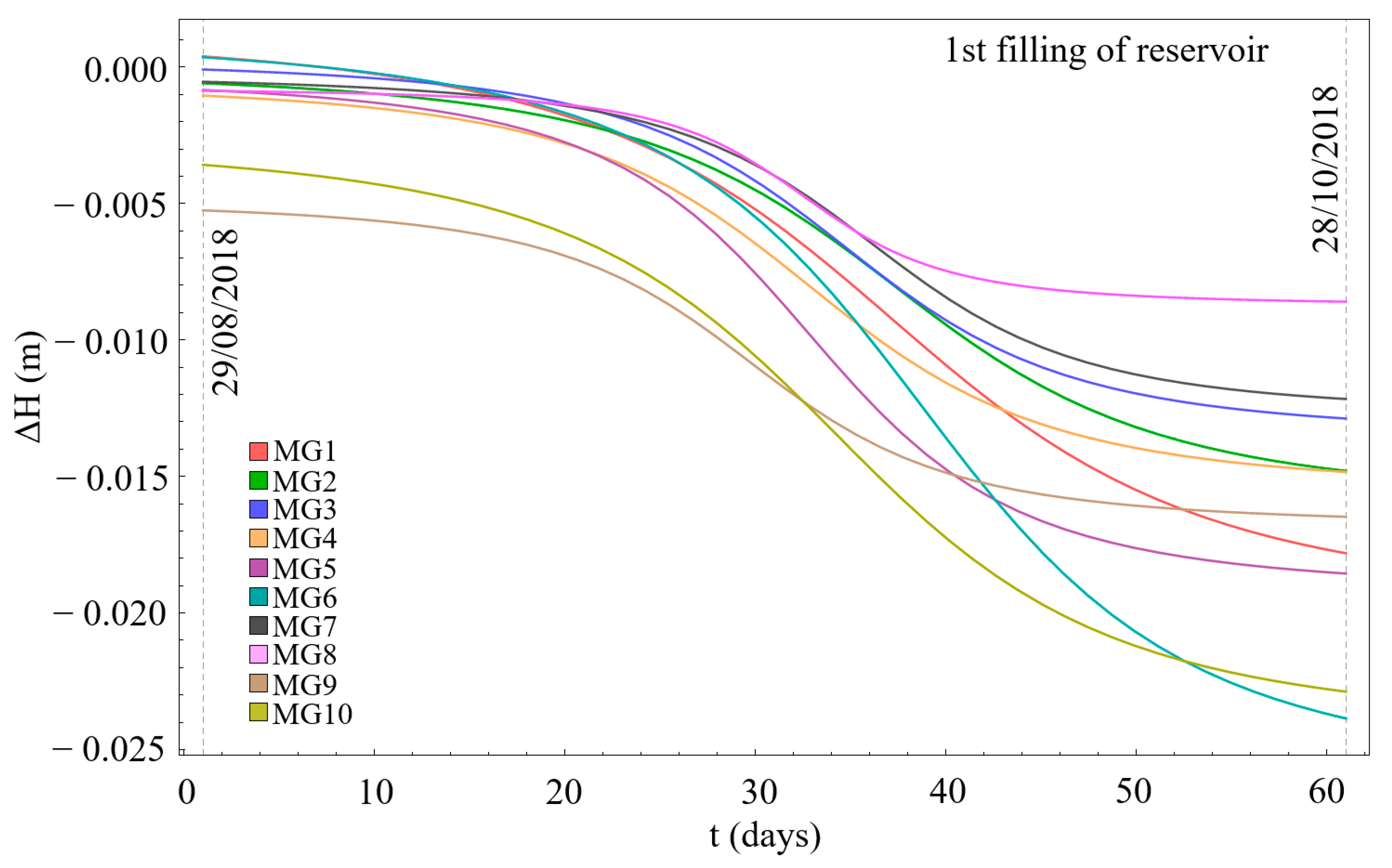
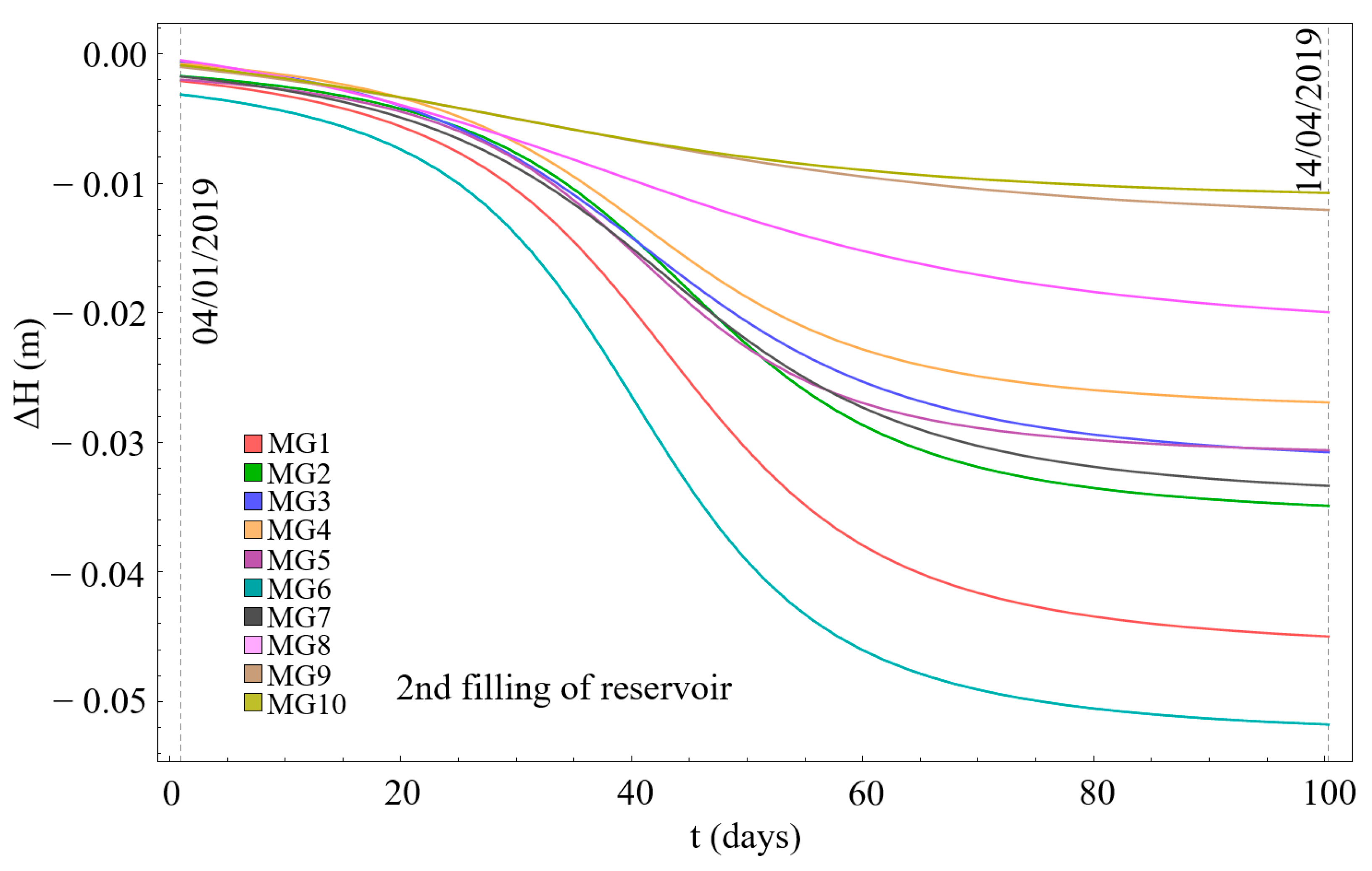

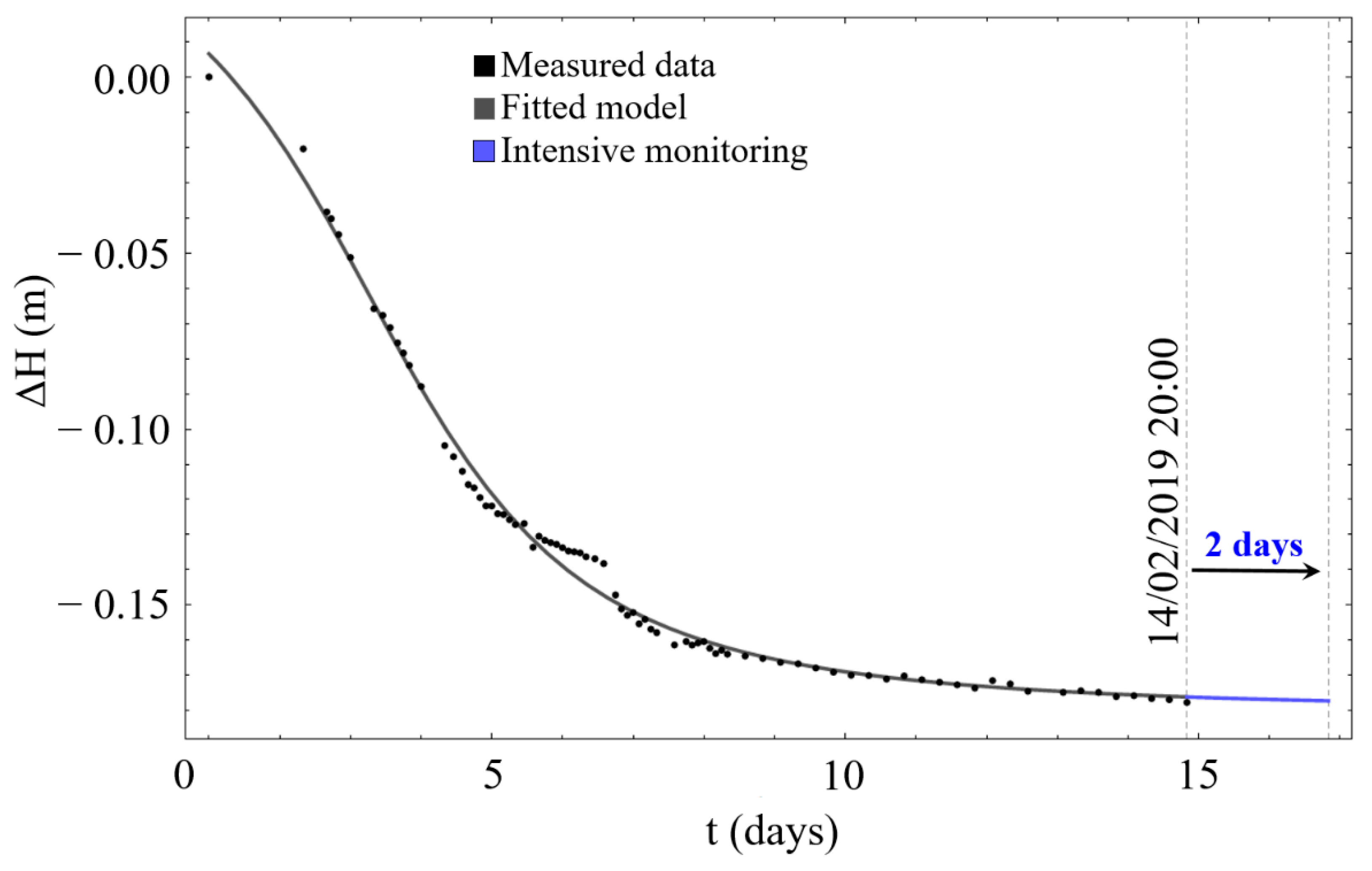
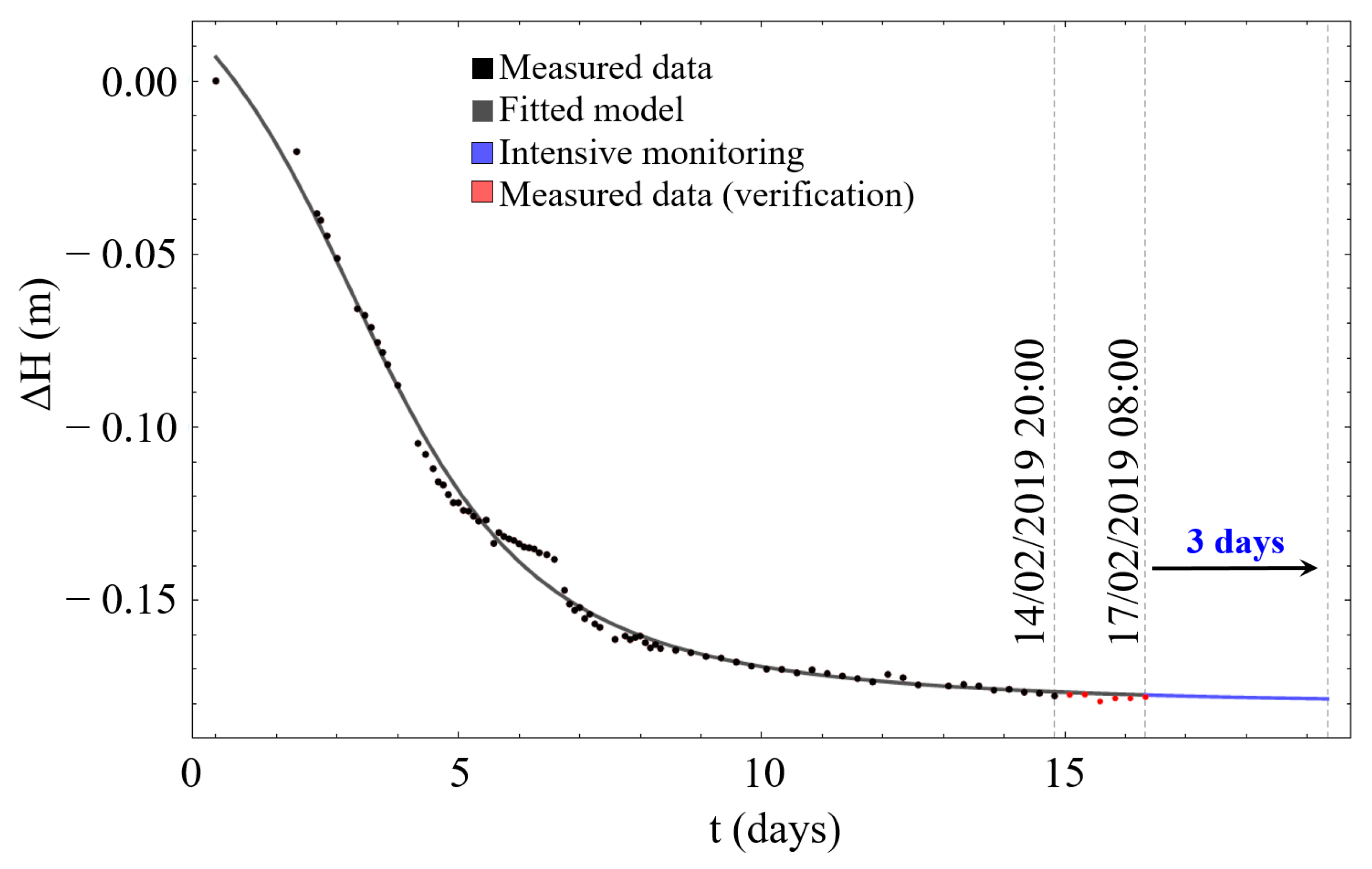
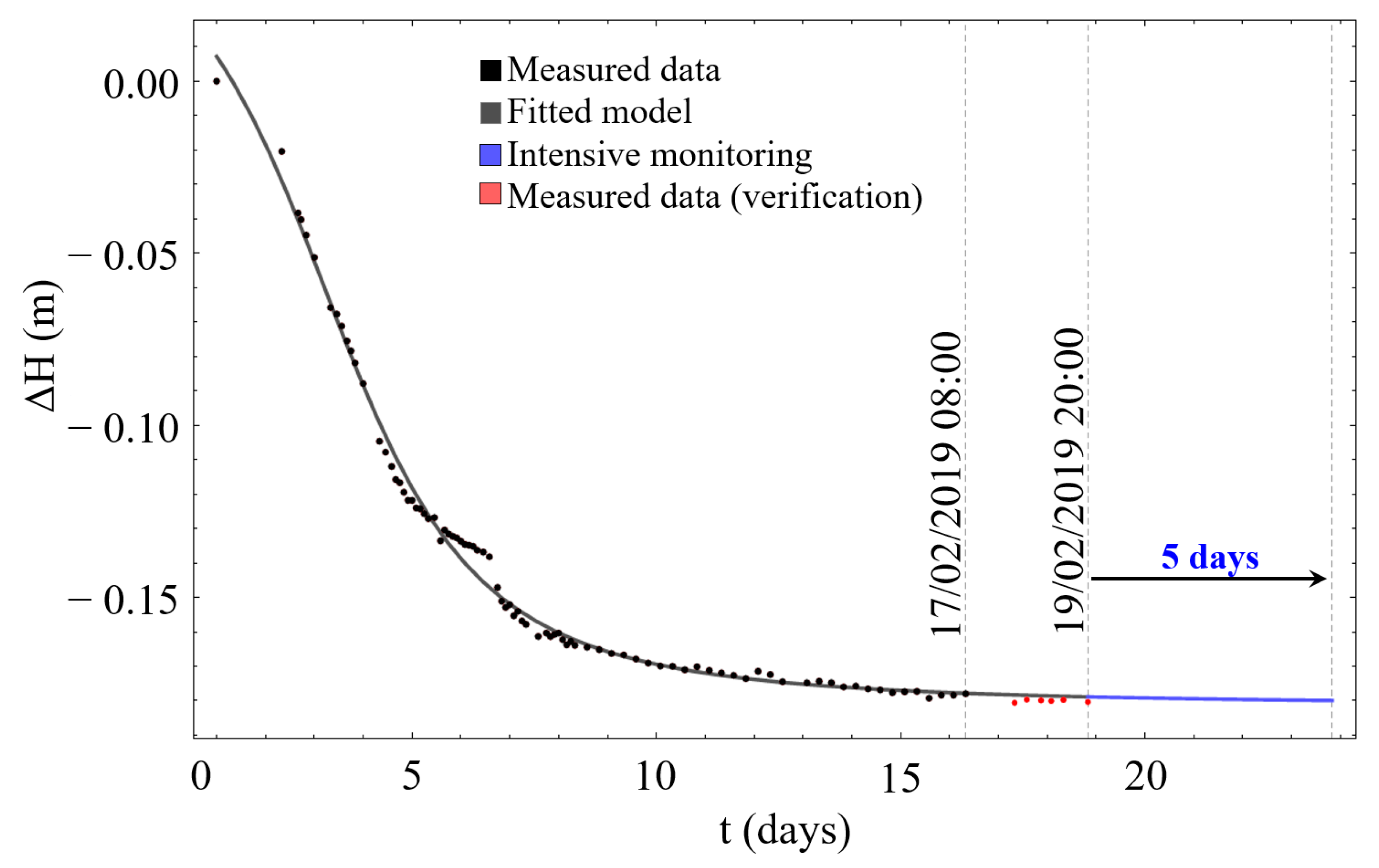

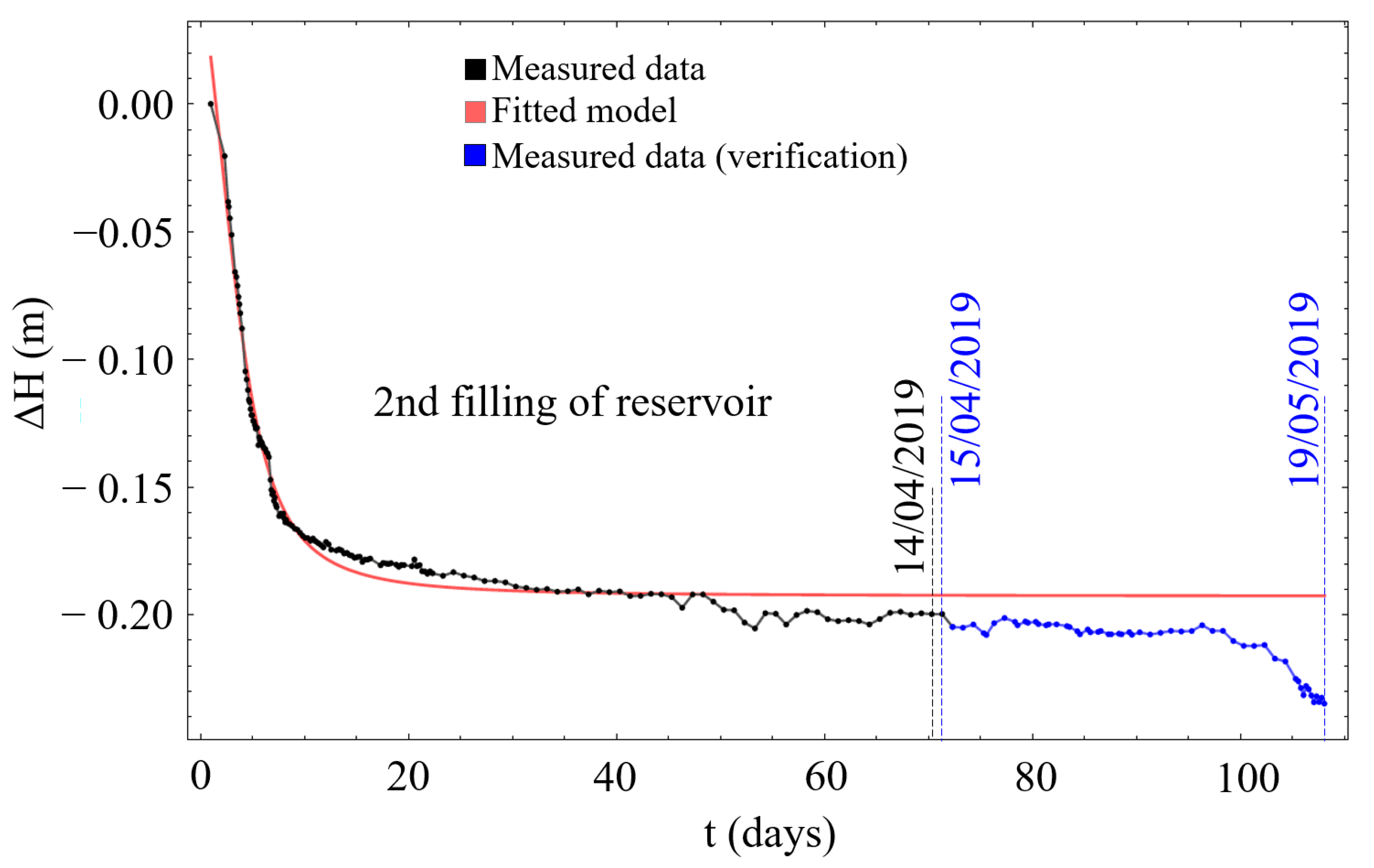
| Point ID | Date | Height (m) | Date | Height (m) |
|---|---|---|---|---|
| MG1 | 29/08/2018 | 1066.1701 | 28/10/2018 | 1066.1518 |
| MG2 | 29/08/2018 | 1066.1211 | 28/10/2018 | 1066.1077 |
| MG3 | 29/08/2018 | 1066.1322 | 28/10/2018 | 1066.1194 |
| MG4 | 29/08/2018 | 1066.1439 | 28/10/2018 | 1066.1302 |
| MG5 | 29/08/2018 | 1066.8808 | 28/10/2018 | 1066.8631 |
| MG6 | 29/08/2018 | 1066.2034 | 28/10/2018 | 1066.1797 |
| MG7 | 29/08/2018 | 1066.1659 | 28/10/2018 | 1066.1550 |
| MG8 | 29/08/2018 | 1066.1234 | 28/10/2018 | 1066.1168 |
| MG9 | 29/08/2018 | 1066.0115 | 28/10/2018 | 1066.0002 |
| MG10 | 29/08/2018 | 1065.9794 | 28/10/2018 | 1065.9602 |
| MG11 | 29/08/2018 | 1037.5917 | 14/10/2018 | 1037.5553 |
| MG12 | 29/08/2018 | 1031.4697 | 14/10/2018 | 1031.4598 |
| MG13 | 29/08/2018 | 1026.0741 | 14/10/2018 | 1026.0867 |
| MG14 | 29/08/2018 | 1022.7454 | 14/10/2018 | 1022.7445 |
| MG15 | 29/08/2018 | 1007.1163 | 08/10/2018 | 1007.1058 |
| MG16 | 29/08/2018 | 1009.3641 | 08/10/2018 | 1009.3605 |
| Point ID | Date | Height (m) | Date | Height (m) | Date | Height (m) |
|---|---|---|---|---|---|---|
| MG1 | 04/01/2019 | 1066.1263 | 14/04/2019 | 1066.0793 | 19/05/2019 | 1066.0798 |
| MG2 | 04/01/2019 | 1066.1211 | 14/04/2019 | 1066.0534 | 19/05/2019 | 1066.0536 |
| MG3 | 04/01/2019 | 1066.1322 | 14/04/2019 | 1066.0725 | 19/05/2019 | 1066.0713 |
| MG4 | 04/01/2019 | 1066.1167 | 14/04/2019 | 1066.0889 | 19/05/2019 | 1066.0884 |
| MG5 | 04/01/2019 | 1066.8522 | 14/04/2019 | 1066.8207 | 19/05/2019 | 1066.8220 |
| MG6 | 04/01/2019 | 1066.1459 | 14/04/2019 | 1066.0925 | 19/05/2019 | 1066.0934 |
| MG7 | 04/01/2019 | 1066.1365 | 14/04/2019 | 1066.1017 | 19/05/2019 | 1066.1025 |
| MG8 | 04/01/2019 | 1066.1042 | 14/04/2019 | 1066.0837 | 19/05/2019 | 1066.0828 |
| MG9 | 04/01/2019 | 1065.9892 | 14/04/2019 | 1065.9766 | 19/05/2019 | 1065.9766 |
| MG10 | 04/01/2019 | 1065.9603 | 14/04/2019 | 1065.9486 | 19/05/2019 | 1065.9493 |
| MG11 | 04/01/2019 | 1031.5272 | 14/04/2019 | 1031.4937 | 19/05/2019 | 1031.4817 |
| MG12 | 04/01/2019 | 1031.6019 | 14/04/2019 | 1031.5852 | 19/05/2019 | 1031.5827 |
| MG13 | 04/01/2019 | 1031.7367 | 14/04/2019 | 1031.7281 | 19/05/2019 | 1031.7274 |
| MG14 | 04/01/2019 | 1031.7920 | 14/04/2019 | 1031.7884 | 19/05/2019 | 1031.7888 |
| MG15 | 04/01/2019 | 1045.9993 | 14/04/2019 | 1045.9554 | 19/05/2019 | 1045.9499 |
| MG16 | 04/01/2019 | 1045.5099 | 14/04/2019 | 1045.4884 | 19/05/2019 | 1045.4876 |
| Point ID | Date | Height (m) | Date | Height (m) |
|---|---|---|---|---|
| MG19 | 02/02/2019 | 1066.8460 | 19/05/2019 | 1066.6112 |
| MG20 | 02/02/2019 | 1058.4349 | 19/05/2019 | 1058.3533 |
| MG21 | 02/02/2019 | 1052.2818 | 19/05/2019 | 1052.2299 |
| DRMG19a | 04/02/2019 | 1066.7785 | 21/03/2019 | 1066.6719 |
| DRMG20a | 04/02/2019 | 1066.6935 | 13/02/2019 | 1066.5630 |
| SSP1 | 06/02/2019 | 1066.4872 | 21/03/2019 | 1066.4530 |
| SSP2 | 06/02/2019 | 1066.8782 | 21/03/2019 | 1066.8746 |
| SSP3 | 06/02/2019 | 1066.2723 | 21/03/2019 | 1066.2226 |
| SSP4 | 06/02/2019 | 1067.0067 | 21/03/2019 | 1067.0006 |
| SSP5 | 06/02/2019 | 1066.4383 | 13/02/2019 | 1066.4033 |
| SSP6 | 06/02/2019 | 1066.4415 | 13/02/2019 | 1066.4114 |
© 2020 by the authors. Licensee MDPI, Basel, Switzerland. This article is an open access article distributed under the terms and conditions of the Creative Commons Attribution (CC BY) license (http://creativecommons.org/licenses/by/4.0/).
Share and Cite
Pal, A.; Potočnik, D.; Vulić, M. Rock-Fill Cofferdam Crest Settlement Behavior Analysis Through Geodetic Monitoring Data. Minerals 2020, 10, 152. https://doi.org/10.3390/min10020152
Pal A, Potočnik D, Vulić M. Rock-Fill Cofferdam Crest Settlement Behavior Analysis Through Geodetic Monitoring Data. Minerals. 2020; 10(2):152. https://doi.org/10.3390/min10020152
Chicago/Turabian StylePal, Andrej, Drago Potočnik, and Milivoj Vulić. 2020. "Rock-Fill Cofferdam Crest Settlement Behavior Analysis Through Geodetic Monitoring Data" Minerals 10, no. 2: 152. https://doi.org/10.3390/min10020152





